On the General Consensus Protocol in Multiagent Networks with Double-Integrator Dynamics and Coupling Time Delay
Abstract
This paper considers the problem of the convergence of the consensus algorithm for multiple agents in a directed network where each agent is governed by double-integrator dynamics and coupling time delay. The advantage of this protocol is that almost all the existing linear local interaction consensus protocols can be considered as special cases of the present paper. By combining algebraic graph theory and matrix theory and studying the distribution of the eigenvalues of the associated characteristic equation, some necessary and sufficient conditions are derived for reaching the second-order consensus. Finally, an illustrative example is also given to support the theoretical results.
1. Introduction
Recently, coordinated control of multiple agents has attracted a great deal of attention in many fields such as biology, physics, robotics, and control engineering [1, 2]. Research on multiagent coordinated control problems not only helps in better understanding the general mechanisms and interconnection rules of natural collective phenomena, but also benefits many practical applications of networked cyberphysical systems, such as the coordination and control of distributed sensor networks [3], formation control in multirobots [4], unmanned autonomous vehicles (UAVs) formations [5, 6], flocking [7], complex networks [8, 9], and so on [10, 11]. A critical problem in coordinated control of multiple agents is to find control laws such that all agents can reach an agreement regarding a certain quantity of interest that depends on the states of all agents. This problem is usually called the consensus problem [12]. In recent years, numerous studies have been conducted on this problem, some special second-order consensus protocols were presented, and some consensus conditions were obtained [13–18].
In the references on the consensus problem, multiagent systems with double-integrator dynamics have been paid great attentions because of their importance in practice. In [13], the authors studied some necessary and sufficient conditions for second-order consensus multiagent system, and revealed that both the real and imaginary parts of the eigenvalues of the Laplacian matrix of the corresponding directed network play key roles in reaching consensus. In [14], Zhu et al. discussed the consensus problem of coupled second-order linear harmonic oscillators with local interaction, which means that the states of all agents converge to the same periodic function. In [15], Zhu discussed a more general linear form of consensus protocols for multiagent systems with double-integrator dynamics. In [16], Li et al. investigated the final consensus convergence state of multiagent dynamical systems by using a kind of generalized linear local interaction protocols without time delay. However, most of the protocols discussed in the existing literature have neither addressed the consensus of positive exponential dynamics, namely, each agent’s state converges to a positive exponential function, nor considered the time delay in network. So, the observation provides us the motivation of this paper to investigate the consensus of second-order agents in directed networks double-integrators and coupling time delay.
In this paper, we consider the convergence of the second-order consensus of multiagent systems composed of coupled double-integrators dynamics and coupling time delay. For this protocol, all the agents in the fixed directed network topology are governed by double-integrator dynamics. The advantage of this protocol is that almost all the existing linear local interaction consensus protocols can be considered as special cases of the present paper [13–16]. By combining algebraic graph theory and matrix theory and studying the distribution of the eigenvalues of the associated characteristic equation, we give explicitly the effect of delays for second-order consensus. The contribution of this paper is to obtain a necessary and sufficient condition that the second-order consensus can be achieved in a delayed multiagent system with a directed spanning tree if and only if the time delay is less than a certain critical value.
The rest of this paper is outlined as follows. In Section 2, some preliminaries on the graph theory and the model formulation are given. The main results are established in Section 3. In Section 4, several numerical examples are simulated to verify the theoretical analysis. Conclusions are finally drawn in Section 5.
2. Preliminaries
In this subsection, some basic concepts and results about algebraic grapy theory are introduced. For more details about algebraic graph theory, please refer to [19]. Suppose that information exchange among agents in multiagent systems can be modeled by an interaction digraph. Let g = (V, ε, A) denote a directed graph, where V = {1,2, …, N} denotes the node set, ε⊆V × V represents the edge set, and A = (aij) N×N is the adjacency matrix. A directed edge εij in the network g is denoted by the ordered pair of nodes (i, j), where i is the head and j is the tail, which means that node i can receive information from node j [20]. The elements of the adjacency matrix A are defined such that aij = 1⇔εij ∈ ε, while aij = 0⇔εij ∉ ε. We always assume that there is no self-loop in network g; that is, aii = 0 for all i ∈ V. Weighted adjacency matrix A of a weighted directed graph can be defined such that aij is a positive weight if εij ∈ ε, while aij = 0 if εij ∉ ε. The set of neighbors of node i is denoted by Ni = {j ∈ V : (i, j) ∈ ε}.
If there is a sequence of edges of the form (i, j1), (j1, j2), …, (jm, j) ∈ ε composing a directed path beginning with i and ending with j in the directed graph g with distinct nodes jk, k = 1,2, …, m, then the node j is said to be reachable from node i. A directed graph is strongly connected if for any distinct nodes i and j, there exists a directed path from node i to node j. A directed graph has a directed spanning tree if there exists at least one node called root which has a directed path to all the other nodes [21]. A directed graph is balanced if for all i. Let (generally nonsymmetrical) Laplacian matrix L = (lij) N×N associated with directed network g be defined as and lij = −aij, where i ≠ j. Especially, for an undirected graph, L is symmetric positive semidefinite. However, L for a directed graph does not have this property.
2.1. Notations
Some mathematical notations are used for simplicity throughout this paper. In(On) denotes the identity (zero) matrix with n dimensions. Let 1n(0n) be a column vector with n elements being 1 (0). Re(·) and Im (·) represent the real part and imaginary part of a complex, respectively. Cn is the n-dimensional complex vector space.
2.2. Consensus Protocols
3. Main Results
In delayed systems, the time delays can be regarded as the bifurcation parameters. In [17, 18], it was found that Hopf bifurcation occurs when time delays pass through some critical values where the conditions for local asymptotical stability of the equilibrium are not satisfied. Similarly, in this section, we aim to find the maximum time delay with which the consensus can be achieved in the multiagent system (1). Before reaching our main results, we first give the following lemmas.
Lemma 2 (see [5].)Let L be the (nonsymmetric) Laplacian matrix associated with directed network g. Then, L has a simple zero eigenvalue and its other eigenvalues have positive real parts if and only if g has a directed spanning tree.
The characteristic equation for system (4) is
In the following, one considers the case that gi(λ) has a pair of purely imaginary roots ±iωi. If iωi (ωi > 0) is a root of gi(λ) = 0, substituting it into gi(λ), one can obtain
Lemma 3. (1) If and , then (8) has no positive root.
(2) If and , then (8) has only one positive root.
(3) If and , then (8) has two positive roots.
Suppose that (8) has positive roots; without loss of generality, one assumes that it has two positive roots defined by ωik, (k = 1, 2). By (7), one has
Define and .
Lemma 4 (see [15].)Consider the exponential polynomial
Let
Lemma 5. Suppose that the network contains a directed spanning tree, and all the roots of (5) have negative real parts if and only if the following conditions are satisfied: δ < 0 and τ ∈ [0, τ0).
Proof. For τ = 0, (5) can be rewritten in the following form:
Also note that (β − ξμi) 2 − 4(α − γμi) = c2 − d2 + i2cd. By some calculations and separating the real and imaginary parts, one obtains
Summarizing the previous discussions, we have the following theorem.
Theorem 6. Suppose that the network contains a directed spanning tree; we have the following results.
Corollary 7. For α = β = 0, γ, ξ > 0, and τ > 0, second-order consensus in multiagent system (1) can be achieved if and only if the network contains a directed spanning tree and
Corollary 8. For τ = 0, second-order consensus in multiagent system (1) can be achieved if and only if the network contains a directed spanning tree and δ < 0. In [15], Zhu investigated the second-order consensus under the linear protocol:
4. Simulation Examples
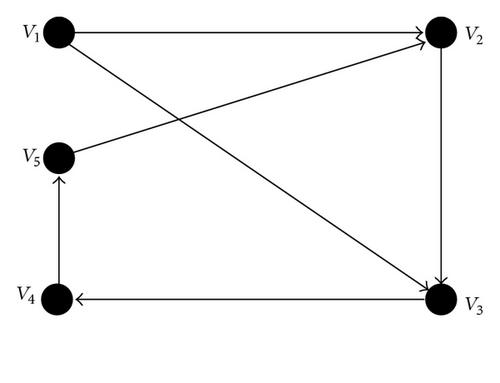
Consider τ = 0.39 < τ0; from Theorem 6, we know that the second-order consensus can be reached. The position and velocity states of all the agents are shown in Figure 2. It is easy to see that the consensus of all agents is achieved.
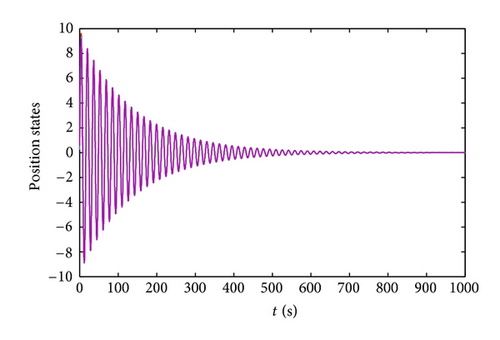
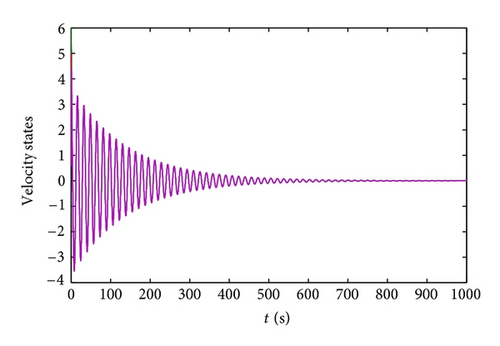
Consider τ = 0.394 > τ0; from Theorem 6, we know that the second-order consensus cannot be reached. The position and velocity states of all the agents are shown in Figure 3. It is easy to see that the consensus of all agents is not achieved.
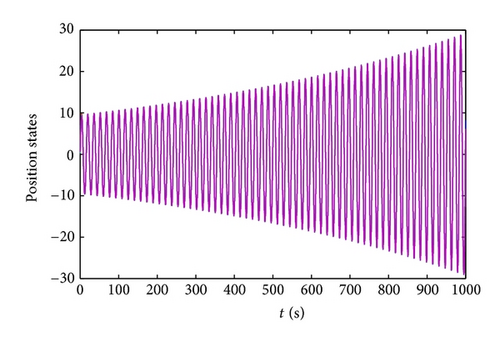
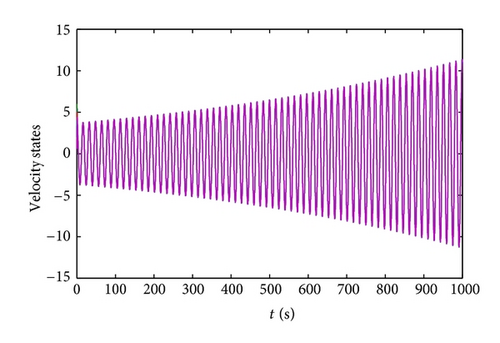
5. Conclusions
In this paper, the convergence of the second-order consensus of multiagent systems composed of coupled double-integrators dynamics and coupling time delay has been studied. The advantage of the considered protocol is that it can be treated as the extensions of most linear local interaction protocols in the existing literatures. By combining algebraic graph theory and matrix theory and studying the distribution of the eigenvalues of the associated characteristic equation, some necessary and sufficient conditions are derived for reaching the second-order consensus. Several simulation results further validate the effectiveness of theoretical analysis.
Acknowledgments
This work was supported in part by Project no. CDJXS12180002 supported by the Fundamental Research Funds for the Central Universities, in part by the National Natural Science Foundation of China under Grant 60973114 and Grant 61170249, in part by the Research Fund of Preferential Development Domain for the Doctoral Program of Ministry of Education of China under Grant 201101911130005, in part by the State Key Laboratory of Power Transmission Equipment & System Security and New Technology, Chongqing University, under Grant 2007DA10512711206, and in part by the Program for Changjiang Scholars.




